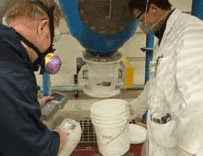NIOSH Nanotechnology Metal Oxide Particle Exposure Assessment Study
March 2008
DHHS (NIOSH) Publication Number 2008-122

The National Institute for Occupational Safety and Health (NIOSH), part of the Centers for Disease Control and Prevention (CDC), is the leading federal agency conducting research and providing guidance on the occupational safety and health implications of exposure to engineered nanomaterials. As part of its nanotechnology research agenda, NIOSH initiated a study to investigate exposure to fine (0.1µm to 2.5µm diameter) and ultrafine (<0.1µm diameter) metal oxides.
Purpose
The purpose of the metal oxide study is to measure and characterize workplace exposure to fine and ultrafine metal oxides in both manufacturing and end-user facilities. The specific objectives are to
- Characterize airborne metal oxides exposure metrics by job or process,
- Obtain quantitative estimates of exposure to fine and ultrafine metal oxides by particle size, and
- Evaluate a strategy for measuring workplace exposure to fine and ultrafine metal oxides.
These objectives will allow NIOSH to determine which processes and job tasks pose the highest risk of exposure to workers. This study is specifically designed to conduct a detailed evaluation of exposures to fine and ultrafine metal oxides, and is not the same as the baseline assessment program offered by the NIOSH nanotechnology field research team. Information on that program is available at www.cdc.gov/niosh/nas/mining/potentialintermediateoutcome41.htm.
NIOSH Nanotechnology Metal Oxide Particle Exposure Assessment Study [PDF – 175 KB]
